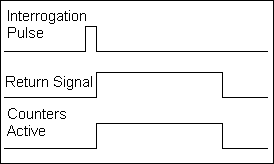
Magnetostrictive displacement transducers are designed for use in rugged industrial environments. They are non-contact, wear-free, highly reliable, and offer accurate and repeatable linear position measurement. In the motion control industry magnetostrictive displacement transducers are typically inserted into hydraulic cylinders for measurement of the cylinders’ extension/retraction position.
Each RMC100 MDT interface module has circuitry for multiple magnetostrictive transducers. Each axis can be configured for a Start/Stop transducer or a Pulse Width Modulated transducer. To make a measurement with a Start/Stop transducer, the RMC sends an interrogation pulse to the transducer. The transducer responds by returning 2 pulses—a Start pulse and a Stop pulse. The RMC’s internal counters begin to count when the first pulse, Start, is received and stop counting when the second pulse, Stop, is received. The time between the start pulse and the stop pulse is proportional to the transducer position.

Start/Stop Pulse Transducer
To make a measurement with a Pulse Width Modulated transducer, the RMC sends an interrogation pulse to the transducer. The transducer responds with a return signal. The return signal is high while the transducer is determining its’ position. The counters on the RMC100 MDT interface module are counting during the time that the return signal is high. The time that the return signal is high is proportional to the transducer position.

Pulse Width Modulated Transducer
The RMC must then convert the counts accumulated during the transducer interrogation to an ACTUAL POSITION in user-defined Position Units (usually 0.001 inch) for use in the PID control loop.
See also:
Copyright (c) 1997-2015 by Delta Computer Systems, Inc.